Hawk heaven
On a ridgetop in Duluth, bird watchers keep eyes on the fall skies.
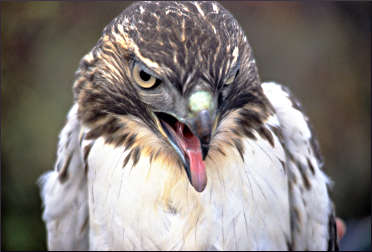
© Beth Gauper
On Duluth's Hawk Ridge, a bird in the hand is worth at least two in the sky.
They're impressive when spotted overhead. But up close, it's easier to get to know a bird — say, the northern goshawk, a fierce predator whose image once adorned the helmet of Attila the Hun.
As she held a young goshawk by the legs, naturalist Willow Maser struggled to make herself heard above its high-pitched screeches.
"It's not that it's so angry or irritated, it's just very territorial and very aggressive," she explained to onlookers. "This is what they do. This is just it saying, 'Hi, I'm here.' "
Finally, she stuffed it into a coffee can. Instantly, the screeching stopped. When Maser pulled it out, the goshawk's brief sojourn in darkness had calmed it down.
In September and October, the migration of hawks along the shore of Lake Superior brings visitors from around the world to this wide spot in the road, 500 feet above the water.
Some of them come every year and stay for a week or two, watching the hawks and socializing with other bird watchers they've gotten to know over the years.
Thousands of birds
Swooping down from northern forests and prairies, funneled over Hawk Ridge by the vast expanses of Lake Superior, the raptors appear by the thousands.
In mid-September, if the day is clear and the winds blow from the west or northwest, broad-winged hawks arrive by the tens of thousands — and on Sept. 15, 2003, now known as "the Big Day," watchers counted a record 101,698.
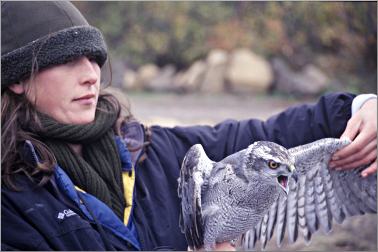
© Beth Gauper
By October, most of the sharp-shinned and broad-winged hawks have moved on and the red-tailed and rough-legged hawks arrive, along with northern goshawks and a few early eagles.
When we went up to Hawk Ridge on a chilly Saturday in mid-October, volunteer coordinator Julie O'Connor was showing off a Cooper's hawk, whose appearance on Hawk Ridge she called a "rare treat."
The hawks were used for target practice until 1950, when the Duluth Bird Club, now the Duluth Audubon Society, asked the city to enforce an existing ban and then organized the first hawk watch.
In 1972, after the club helped the city buy the highest part of the ridge, a banding station opened in the nearby brush and the first systematic count was made.
A naturalist program started in 1974, but even today, there's no visitors center at Hawk Ridge Nature Reserve, just a display board amid the rocks and a portable toilet down the dirt road.
It does have staff naturalists and a dedicated corps of volunteers, and they man the main overlook every day in September and October, talking about raptors and showing visitors whatever bird has just been captured, weighed and banded.
When we were there, volunteer Bruce Pomeroy explained how birds often are the bellwether of the environment. After September 2003, he said, birders realized the massive numbers of broad-winged hawks flying through had been blown over from Eastern states by Hurricane Isabel.
"Everything is connected," he said. "On Sept. 1, the food chain is on the move. First, the bugs leave from here, and then the dragonflies from Canada. Then, the songbirds, who eat the dragonflies, and the sharpies, who eat the songbirds.
"Then, it's the Cooper's, who eat the sharpies, and the goshawks, who eat them both. The whole food chain is going right through here."
A corps of counters
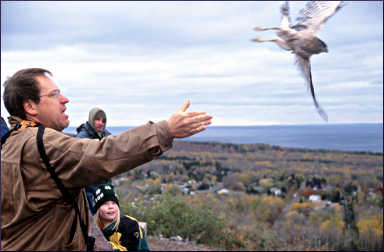
© Beth Gauper
When we returned the next day, Pomeroy took us to the banding station, where a starling, a dove and a pigeon in little harnesses waited in a clearing. When a raptor appears overhead, banders jerk the line of the bird most likely to tempt it; if the raptor goes for it, a net flops over them both.
"People ask, 'Do the birds get hurt?' " Pomeroy said. "Well, you've got six talons coming at you at 40 mph. Some get hurt, and some don't. It's the luck of the bird."
As we sat in a tiny shack, peering out a narrow opening, Pomeroy provided a running narration from both the banders' and the birds' points of view.
"Here comes a red-tailed hawk to look over the bait .... He's going ... no, that's too perfect. Oh, he's coming in . . . no, he's going to sit on a pole. Now, they have to trick him again, pulling on the ground. This is like fly-fishing. He's going . . . no, that don't seem right."
The suspicious red-tail flew off, but then a goshawk went after the dove, which disappeared under the net in a flurry of feathers — one of the unlucky ones.
Soon, we heard a familiar screeching, and the bander came to show us a young goshawk sporting a new aluminum leg band.
"Goshawks are fast; they're able to wheel up if they see the shimmer of a net," Pomeroy said. "The immature ones are captured most; they're hungry and brash."
Back at the main overlook, a volunteer brought out the day's count as of 3 p.m.: 73 bald eagles, 61 sharp-shinned hawks, 55 northern goshawks, 449 red-tailed hawks, 105 rough-legged hawks, 15 golden eagles and seven turkey vultures.
Led by sharp-eyed veteran Frank Nicoletti, counters scan the skies through November, identifying some birds with the naked eye and others through binoculars, perhaps by the angle of a neck or length of a tail.
A red-tailed hawk flew overhead, and we watched as it plunged over the banding station. Ten minutes later, the staff radio crackled.
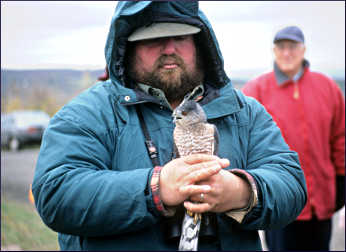
© Beth Gauper
Soon, we were looking at a hatch-year hawk still in baby feathers, with a disfigured beak and dried blood on its feet from a recent meal. Instead of screaming, it glared at us and kept its beak wide open — the red-tail's show of aggression.
It was a little underweight, only 700 grams, and its tail had only the barest tinge of the red it would later become. But to the onlooker who got to fling it back into the sky, it was the most beautiful hawk in the world.
For seasoned bird watchers, a Big Day is seeing thousands of hawks. But for us, seeing even a few of these splendid birds was Big Day enough.
Trip tips: Hawk Ridge in Duluth, Minnesota
Getting there: Hawk Ridge is along Skyline Parkway in East Duluth.
People driving up Interstate 35 should turn right onto London Road, also Minnesota 61. Turn left onto 43rd Avenue. At Glenwood Street, turn left, then right onto Skyline Parkway.
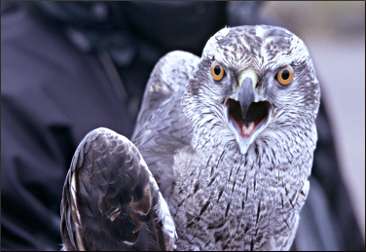
© Torsten Muller
When to go: Volunteers and naturalists are on hand every day from late August through October. Weekdays are a good time to go, because weekends can bring crowds, even busloads, of people.
Unlike other wildlife, hawks are most active in the middle of the day, after the sun warms the air; the best hours are 10 a.m. to 2 p.m. Migration is heaviest on clear days when wind blows from the west or northwest. If it's rainy or foggy, birds won't fly.
Hawk Weekend Festival normally is the third full weekend in September and includes special programs and field trips and seminars in nearby bird-watching areas. Register in advance.
Guided hikes, beginning hawk-watching programs and talks about owls and other raptors also are offered.
Visitor tips: Wear warm, windproof clothing, including a hat and gloves. If you want to watch the skies, bring binoculars and a chair.
On weekends between mid-September and mid-October, a food truck sells brats, hot dogs, chips and drinks.
Here's how to tell the difference between Cooper's hawks, sharpies and goshawks.
Lodging: Reserve as soon as possible, especially for weekends.
For more, see Duluth 101.
Information: Hawk Ridge, 218-428-6209.